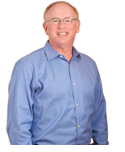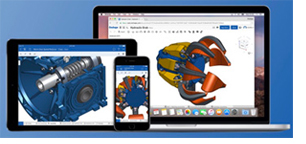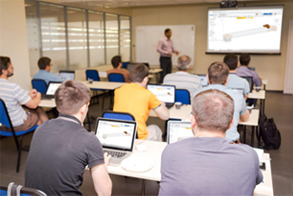COFES Institute Interview with Jon Hirschtick
Posted on November 20th, 2017 in Uncategorized | No Comments »

Today we are proud to share our second COFES Institute newsletter, with our interview of Jon Hirschtick, Co-Founder and Chief Executive Officer of Onshape.
COFES Institute Interview with Jon Hirschtick
November 2017
 Jon Hirschtick
Jon Hirschtick
Co-Founder and Chief Executive Officer
Onshape
Jon holds a Bachelors and Masters from MIT, and has worked in CAD for over 30 years. He was a Founder and CEO of SolidWorks, a group executive at Dassault Systemes, director of engineering at Computervision, manager at the MIT CADLab, a player and instructor on the MIT Blackjack team, and a professional magician. He serves on the Engineering Advisory Board at Boston University and as an advisor to Magic Leap, Inc. and MarkForged, Inc. His hobbies include golf, 3D printing, tennis, yoga, and magic.
SW: The theme of the upcoming COFES event is human-assisted design. I’d like to get your perspective on the transition underway toward human-assisted design. Let’s use generative design as our launch point into the discussion.
JH: Generative design is a great idea for certain design problems that will undoubtedly be a very useful tool to add into the CAD tool set for the designer. However, I don’t think we are at a point where design itself is going to get completely automated. It’s too complicated a domain. You need to think about so many aspects of a product, including how it looks and how strong it is (which is typically the focus of generative). I would note that for years now, the computer has been somewhat synthesizing geometry.
For instance, in Onshape, we have an n-sided fill surface command. You give it boundaries and it fills in the surface. You give it different kinds of controls that influence the shape of the surface, but don’t precisely define it. The system comes up with the smooth surface based on what you tell it. It is not like we have been explicitly defining every little piece of design. For quite a while now, we’ve been giving certain inputs. I think what you see is more and more power in the engineer’s toolbox and generative design is one example of that along with others.
SW: Let’s talk about CAD in the cloud. Give us some perspective on what the cloud brings to CAD.
JH: For our customers, it brings three things. One is access. You can access your tool on any device. That’s huge because access and deployment are a much bigger issue in the environment of modern design teams. The second thing it gives you is an illumination of what I will call “design gridlock.” What happens today is everyone is waiting on each other: Where’s the file? Where’s the latest version? There are concerns about overwriting design changes. The only way to moderate that in old-style CAD is to do locking.
 The third thing is eliminating crashes and data loss. Cloud systems don’t really crash. At SOLIDWORKS, we spent all of our time chasing down bugs and crashes, mostly. At Onshape, we don’t even have a category for crash bugs. The experience associated with a crash is you disrupt your workflow and you lose data to varying degrees of severity. With Onshape, you might have disruption, you might have something fail, but disruption means, “Hmmm… strange message in my browser, I’ll hit refresh, boom, it’s back and the data is right back there.” You lose no data. Our customers love these three things – access to the system, eliminating design gridlock and never losing data.
The third thing is eliminating crashes and data loss. Cloud systems don’t really crash. At SOLIDWORKS, we spent all of our time chasing down bugs and crashes, mostly. At Onshape, we don’t even have a category for crash bugs. The experience associated with a crash is you disrupt your workflow and you lose data to varying degrees of severity. With Onshape, you might have disruption, you might have something fail, but disruption means, “Hmmm… strange message in my browser, I’ll hit refresh, boom, it’s back and the data is right back there.” You lose no data. Our customers love these three things – access to the system, eliminating design gridlock and never losing data.
Let me add that you have to look at these benefits of CAD in the cloud through the lens of the modern design team. What we provide is a value because of changes in the way people design. It is not a team under one roof that is static, working in a room. It’s a distributed team. And it is not just about engineers. You want to be able to share with everyone involved in the process.
SW: How do you see Onshape and CAD in the cloud evolving as we process in the digitalization of manufacturing?
JH: Another buzzword I will throw out there is “Industry 4.0.” You talk about having a global, real-time, single source of truth. Onshape is the only system in the world today that has a global, real-time single source of truth where there are no offline copies, no downloading and no syncing. If you and I were to work on an Onshape model right now, we could be collaborating within minutes. You would see the same model I see. It is impossible for us to be looking at different models. In the world of Industry 4.0, we are the only system that does that today. In the world of additive, it is something that fits beautifully with what we are doing because you generally are working faster with an extended team and more complex shapes. And all of that amplifies all of the benefits of CAD in the cloud I described earlier.
We have a partner program with a complete set of additive tool chain partners, including shape optimizers, shape generators and simulation partners like SIMSOLID. We are talking to ANSYS. Their Discovery Live product is a very exciting product. I think this product is very useful to additive because you don’t have to mesh the models. In summary, I think you are going to see process change because of additive, and a need for working with new types of geometric shapes. And with respect to both of those, I think Onshape is perfect.
SW: How do you see CAD in the cloud evolving along with emerging technologies such as augmented reality, virtual reality, machine learning and artificial intelligence?
JH: We can tie these back to the three major benefits of CAD in the cloud discussed earlier. I’ll start with accessibility. Because we can run on any kind of device, anywhere, we have this global, real-time, single source of truth. You look at VR or AR or my favorite, which is Mixed Reality, we are very well set up to support these with real-time collaboration, and the fact that we don’t put the CAD on the device. We don’t have to port a CAD system to run it. We might want to build a very small client app for those devices. That is something we are quite interested in. We have announced we have a partnership with Magic Leap. I’m on their Advisory Board. We will be talking more about that partnership in the future as it evolves. I’m pretty bullish about these emerging technologies. They have the potential to improve the way everything gets designed.
SW: How do you think about integrating machine learning and AI into Onshape?
JH: That’s a great question. I think we have a big opportunity. We collect more data about what people do with the system than any other vendor. I’m hoping we can use that data in the future to make design tasks easier. There are two ways to look at it. There’s a top-down way and a bottom-up way. I would argue that generative design is an AI’ish algorithm anyway, in a sense. I would also say that from a bottom-up standpoint, we might start by giving people more automation at low-level tasks. For instance, say you want to put a hole in a design, you ask the computer to suggest the right diameter. Or I am going to put in an extrusion feature so it selects the right depth. Or, I am going to make these parts and it suggests the right mates. CAD systems have been doing some of these things for a while. I think we can do more and maybe we use AI and machine learning to do more.
 Another thing the system might do is to recognize common patterns of modeling. Unfortunately, I can’t actually say which of these will come along. I can say we are looking at it. I think there is great potential here. But all of these things you have mentioned – machine learning, additive, generative design, cloud CAD – they all help the engineer, but they don’t do the design. Humans do the design. I heard somebody in Silicon Valley recently say that machine learning is getting good at anything a typical human can do in less than a second. In sum, I think we are going to be able to build better design tools through the use of machine learning and AI to take some of the drudgework away. We are going to be able to add a lot of great tools going forward.
Another thing the system might do is to recognize common patterns of modeling. Unfortunately, I can’t actually say which of these will come along. I can say we are looking at it. I think there is great potential here. But all of these things you have mentioned – machine learning, additive, generative design, cloud CAD – they all help the engineer, but they don’t do the design. Humans do the design. I heard somebody in Silicon Valley recently say that machine learning is getting good at anything a typical human can do in less than a second. In sum, I think we are going to be able to build better design tools through the use of machine learning and AI to take some of the drudgework away. We are going to be able to add a lot of great tools going forward.
SW: Managing complex problems are a big deal with the design process. How does Onshape help ease the burden associated with the complexity?
JH: With complex processes, you have lots of people, lots of data and complex decisions. First of all, we help with lots of data. We have what we call a compound document structure where you can throw anything into an Onshape Document – PDF files, datasheets, spreadsheet data, text data, G code – whatever you want. You can put that into your document. It is shared and versioned with everyone instantly. We support branching and merging, which is really helpful as a way to explore different options and decisions. We facilitate groupthink through eliminating the gridlock of sharing data. So we can really help a team work on hard problems, but ultimately they do the work and they solve the problems. We are not in the intellectual set of tools that structure decision-making or help organize alternatives. We don’t do that at Onshape.
SW: I wanted to get your thoughts on how blockchain technology might be integrated into what you are doing at Onshape. You may have seen Julus Urbach’s piece on Medium talking about a Render token using the Ethereum platform.
JH: I have thought about it. I think that where we could use blockchain is to pay for computing or services. I think that is really neat. If we had a coin we could use to buy rendering that could be useful. The other thing we could use it for is to secure providence, if that’s the right word, of information in manufacturing. One of the problems with existing CAD is you send perfect digital masters of your data around. We vastly reduce that because you aren’t sending anything around. But then at some point if you want to 3D print the design you have to send the digital representation to the machine. Today, that is completely uncontrolled. That’s when it leaves the wall, so to speak.
We take a giant step toward expanding the secure boundary of data from just the server to everyone’s device, but we don’t go right to the nozzle on the 3D printer. The 3D printer could be secured in the future through a blockchain system where you say, “I have this model I’ve been asked to print. I am going to authenticate with the owner of it that I’m authorized to print it.” And the owner says, “You are authorized to print it once.” With the blockchain, there is a record of the one-time printing job. We could do that type of application. We could also say, “I know that this part is the one that was authored by Jon and Steve on this date and labeled B-34.” I know this not because there is a filename or an email. I know it because of the blockchain. This type of application is way more exciting to me than mere payment.
SW: We have time for one more question today. You have been a past participant of COFES. What are two or three things that you have taken away from attending the event that have been a big value add to you and your business.
JH: Yes, I’ve been to at least ten COFES events. The first thing that COFES gives me a chance to do is have personal contact and meetings with people of great influence and value in the industry. Number one to me is I can sit down in a relaxed way, free of a business agenda, free of an obligation to get to my booth or whatever, and talk to other people like me in the industry. That to me is the first key thing I love about COFES.
The second key thing is COFES gives me a chance to meet new people, and hear about ideas or products that we haven’t really ever considered before. That has happened many times at past COFES events. I suppose if I had to add a third thing, it is that COFES also gets me out of my four walls in a place that isn’t filled with day-to-day business.
SW: Thank you for your time, Jon. It has been terrific speaking with you today. We look forward to seeing you at COFES 2018.

Steve Waite is a member of the COFES Institute Advisory Board. He is the author of several books, including Quantum Investing and Venture Investing in Science.
—————————————————
From the COFES Vault
In each newsletter, we are going to showcase a talk from a previous COFES event. There is a large collection of material on the COFES website that we encourage members to view at their convenience.
In this newsletter, we would like to share a talk that Murray Cantor, Founder and CTO of Aptage, gave at COFES 2017. Murray and his colleagues are working with companies to track risk in the innovation process. Murray’s talk can be found here: Murray Cantor – Tracking Risk in Innovation
—————————————————
I hope you enjoyed our second COFES Institute interview. I would like to thank Jon and Steve for their participation. Jon and Steve will both be participants at COFES 2018.




